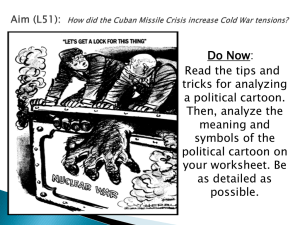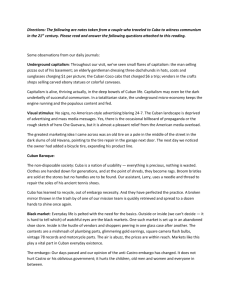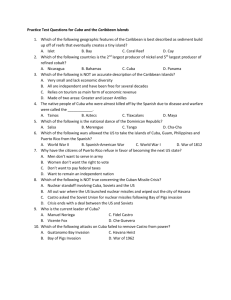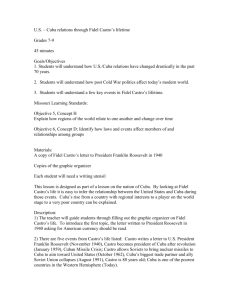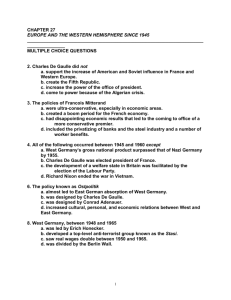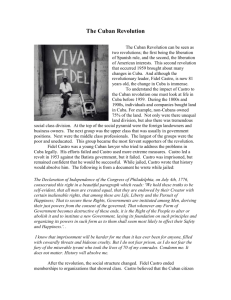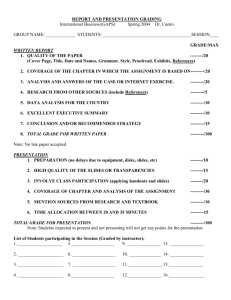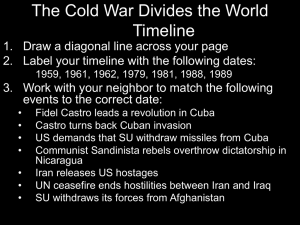File - Mr. O'Sullivan's World of History
advertisement
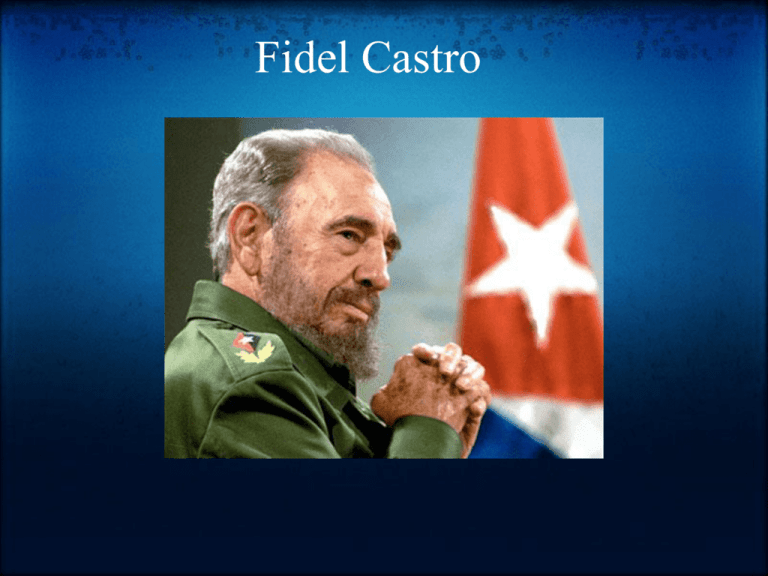
Fidel Castro A Very Brief Summary of Cuba • Cuba was originally ruled by Spain until a treaty in 1902 due to a war and United States intervention in the SpanishAmerican War. The same year, Cuba became an independent state on paper. However, US occupation continued and applied the highly unpopular Platt Amendment. • However, Cuba has a history of rebellions, coups, corrupt elections, and overthrows. Between 1902-1959 (57 years), Cuba experienced 4 changes in leader through the methods mentioned. • Cuba is largely an agricultural economy. It’s top two exports are sugar and nickel. It has a population of about 11,000,000 people. The Leader: Who Was He? • Fidel Castro Ruz was born August 13, 1926 as an illegitimate son of a sugar cane planter. • He went to the University of Havana to be a lawyer and was very politically active as he joined many groups that wanted to achieve political power. • By the time he achieved his degree, he was already participating in political uprisings. Mini-Biographies: Raul & “Che” • Raul Castro was the younger brother of Fidel Castro born June 3, 1931. He is a loyal supporter of Castro and his reforms. He was exiled to Mexico along with Fidel in 1955. Raul played a vital role in overthrowing along with “Che” in military tactics. In 2006 he became President of Cuba when Fidel was ill & needed surgery. He strove for economic reforms to increase productivities in the government. • Ernesto “Che” Guevara was born June 14, 1928 in Argentina. He joined a leftist movement in Guatemala with Jacobo Arbenz. However, when Arbenz was overthrown, he fled to Mexico where he met the Castro brothers. Later, in 1956 he went with them to Cuba to help overthrow Baptista. He was vital in that he was a skilled guerilla tactician. When the overthrow was successful, we implimented vital economic policies in which ties to the United States were severed and nurtured ties to Communist countries. The Others: Raul Castro &“Che” Historical Background: 1940s • Between 1934 and 1940, Batista gained power and controlled Cuba by the "Revolt of the Sergeants". • In 1940, a Constitutional Convention was held that created a new constitution for Cuba. Batista was elected the constitutional president. • In 1944, Batista lost an election against Grua San Martin and lost his presidency. Four years later, Grau's successor Carlos Socarras becomes president. • During Socarrras' regime, Political groups were created to stop communism in the unions. They would able to kill people and get away with it because they used the University of Havana as their refuge, where no military police were allowed according to the constitution. • Batista saw this as an opportunity for a coup (March 10, 1952). Historical Background: The Cuban Revolution • When Fidel Castro was running for election, Fulgencio Batista succeeds in staging a coup and became the dictator of Cuba. March 10 1952 • In response to the coup, Castro joined a group to overthrow Batista. • Cuban Rebels attacked the Moncada Barracks in Santiago, Cuba and also the barracks in Bayamo, Cuba in July 26 of 1953. o 60 rebels died: 5 died fighting, Batista killed 56. • Fidel and his brother, Raul, were jailed in the Isla de Pinos prison. Fidel for 15 years and Raul for 13 years. • In 1955, Batista freed all political prisoners in Cuba because of political pressure. The Cuban Revolution • Fidel Castro went to Mexico to prepare a revolution against Batista. o There he met and joined forces with Che Guevara o Trained by Alberto Bayo- a leader in the Spanish Civil War. • The Granma (yatch) arrived in Cuba and the rebels made their way to Sierra Maestra, where they were attacked by Batista’s army. • In the mountains, Raul and Che helped Fidel gain control by killing Bastista supporters and Castro rivals. • In January 1 1959, Batista left the country and Castro took leadership control. Cuban Revolution Leaders Fidel Castro, Raul Castro, and Che Guevara in Havana 1959 Castro's Ideology I • Castro's plan was known as "Stealth Socialism." o He didn't want people to know what he was planning. • He wouldn't share his political plan with anyone. • Castro and "Che" created "The New Man's Theory." o Work to benefit everyone in the society. • He wanted to restore Cuba's wealth, get back the land Cuba lost, and strengthen the nation's identity. Castro’s Ideology II • Castro believed in “unitary democracy” over “adversary democracy.” • Unitary democracy is when each individual has a vote and decisions are made through a majority opinion. Adversary democracy is voting for representatives. • Another key difference is that he believes in “democratic centralism” versus “liberal democracy.” Castro's Platform • Castro implemented almost impossible reforms to nationalize factories and plantations. • Wanted to makes his armies stronger for Cuba's defense; created an alliance with the USSR during 1960. • Castro intended to build a socialist state with a stateowned, government planning economy. • Stopped private profit business so that all of Cuba had equal job opportunities and boost the economy. • According to constitution, all Cubans were entitled to receive free medical, hospital, and dental care. • All citizens had the same rights regardless of who they were. • Provided payment for elders and pregnant women workers. • The right to free education to the highest university level. Why was Castro Successful? • As a lawyer, had much charisma. He used it to his advantage to convince people to his side. One of his well known speeches was made as a self-defense in court after the Moncada attack where he said, “But I do not fear prison, as I do not fear the fury of the miserable tyrant who took the lives of 70 of my comrades. Condemn me. It does not matter. History will absolve me.” • Even if people didn’t agree with his ideology, the peasant, who largely made up his support, were swayed by the idea of improving their lives and of gaining land for themselves. • However, as Castro based nationalist and populist issues known, the middle class started to side with Castro as well. Elimination of Opposition • The main idea of Castro’s over throw of Baptista was to deprive Baptista of allies and forced him to flee, resign, or killed. Though in the end, Baptista did flee. • Castro gave the option of dissenters to leave Cuba via a port open for them. • Other forms of elimination would be censorship. Castro censorship the media that gave capitalist ideas, but did allow petitions and revision of government within socialist bounds. Propaganda “United we fought… united we win.” Totalitarianism • Attracting support – 1947 Castro joined the Cuban People's Party – 1952 Fidel Castro became a candidate for Congress for the Cuban People's Party. • The party was predicted to win the election but Fulgencio Batista won. – 1953 Castro attacked the Moncada Army – He was send to trial and was sentenced to 15 yrs. In prison • During his trial he said Cuba’s problems and how he could solve them. http://media.wkrg.com/images/sized/media/news/02-222008_castro-300x225.jpg Totalitarianism • Attracting support – Batista allowed Castro to be released after 2 years due to public demand. – In 1956 Castro and many others went to Cuba they were known as July 26 Movement. • They wanted to set up a base in the Sierra Maestra mountains – Batista would order his army to attack civilians in order to gain information. • Caused many people to go against him • 1958 ; 45 organizations signed an open letter supporting the July 26 Movement – Castro marched into Havana on January 9,1959 and became Cuba's new leader. Totalitarianism • Forms of government control – controls the centralized economy, labor market and the media. – 1959-Castro signed First Agrarian Reform Law (limited the size of land holdings and forbade foreign property ownership.) – Castro announced an end to democratic elections in Cuba – denounced American imperialism. • Repression of opponents – Castro accepted economic and military aid by the soviet union. – a trade agreement signed in order to buy oil from the Soviet Union and established diplomatic relation – 1966, Castro founded the Asia-Africa-Latin America People's Solidarity Organization in order to promote revolution. – executions and imprisonments, and forced emigration. http://cuba.foreignpolicyblogs.com/files/2009/03/1nyprotest.jpg Totalitarianism • Extent of opposition – Proyecto Varela is a group that demanded freedom of press. They gathered over 10,000 signatures and the government responded by making their own petition drive to make the socialist system "untouchable (99% voter approval.) – In 1960 U.S. companies and properties are nationalizes. – Defense of the Revolution committee is established to watch over enemies. – January 1961 the US ends diplomatic relations with cuba – 1962 Castro is kicked out of the group Organization of American States – 1980 activist Ricardo Bofill is arrested for spreading "enemy propaganda“ – 1984 The U.S. and Cuba reach an immigration agreement,. – An anti-Castro station funded by U.S. is launched. And the Cuban government blocks the signal. Castro and Status of Women • Once he took power he believed in equality between sexes. • He believed that women deserved rights. • After the Cuban revolution women’s status changed • The Cuban constitution gives women economic, social, political, cultural and family rights and opportunities that are equal to men • "The liberation of women is dependent upon the Revolution's success in attaining its primary objectives: to establish a wholly socialist economy and society. Women can be free only to the extent that they commit themselves first and foremost to the Revolution.“1 Castro and Status of Women • Article 32: enforces that women and men have equal rights. (social, economic, political, cultural) • Article 41: All citizens have equal duties • Article 42: Sex discrimination is forbidden • Article 43:Everyone has the right to education, work and career advancement, housing, transport and public areas. Castro and Religion • After the revolution in 1959 Castro restricted religious practices. • From 1959-1961 many catholic priest left Cuba. • Believes in the separation between church and state. Castro and Religion • In 1992 he agreed to loosen restrictions on religion. • Christmas became officially a holiday in 1997 • “I feel a great respect for all religions.” -1998 speech The Downfall The factors that led to Castro's downfall are: • The Cuban Crisis • The Decline of Cuban Sugar • The Emergence of Anti-Castro Groups • Alliance System • The Unied States Embargo Act of Cuba • Castro's Security Threats • Castro's Illness The factors listed above caused the downfall of Fidel Castro which falls under political, ecnomical, and social issues in Cuba. The Cuban Crisis • Castro's ineffective ways of leading the conomy delayed the free markets in Cuba and the progress and prosperity of the economy. • Central Planning Board (1960) was an attempt to control the Cuban economy. • The Revolutionary Law of 1963 eliminated private businesses and free market activities. • The Institute for Agrarian Reform nationalized private farms and agricultural systems. • Alliances are weaken between the Soviets and Russia. • The supplier of oil, limber, food, and spare machine parts ended. • The Soviets were only able to deliver 8.6 million tons of oil to Cuba, instead of 10 million tons. The Decline of Cuban Sugar • Sugar is Cuba's staple agricultural export which is consists of 75 % of Cuba's export income • The production of sugar has decreased from 8.1 million tons to 5.5 miillion tons. • The failure of sugar production, due to unable to purchase proper fertilizer/farm equipment, agricultural machinery, and low international sugar prices. • To make matters worse, all Soviet trade subsidies to Cuba were eliminated on January 1, 1992 where the power is transferred to the former Soviet republics. • The shortage of aid for energy had caused a ration for gasoline, diesel fuel, and liquid gas and affected factories, transportations, and constructions. • Castro response was to have 'perfect socialism' and that 'Cuba is ready to confront the world alone through socialism' Emergence of Anti-Castro Groups As the ecnomy continues to deteriate,two groups formed in Cuba: those who oppose Raul and Fidel Castro and those who support. Cuban Democratic Coalition Democratic Convergence (Disagree) (Agree) • Led by Daniel and Thomas • Led by Elizardo Sancez, a Aspillaga. professor of Marxist • Seeks a transition to democracy philosophy. and supports the contiunation of• Negotiates to improve the US economy sanctions. human rights, but do not call • Calls for democratic elections for elections. and respects for human rights. • More likely to expand due to bureaucrats, military personnel and etc. Alliance System • As Cuba's former communist allies ended, he searched for new allies and dictatorships. • Tried to allie with China which is the most significant trading power in Latin America. • In 1990, the trade between China reached $420 million: Cuba exchanging citrus fruit, medical products, and sugar for China's food supply and industrial goods. • Also, signed a trade protocol of exporting biotechnology products, tobacco, and rum for bicycles, clothing and textiles. • North Korea provide Castro's government with technical assistantance for Cuban sugar. The United States Embargo Act • The embargo restricts United States exports to Cuba and vice versa. • Forced Castro to cut government spending and reduced his support for Third World communist regimes and caused difficulties to the economy. • Annually Cuba depended on United States imprts, but have to rely on less advanced, cheap supplies from the former Soviet Union and Eastern Europe, instead. • Limited to export to the Third World, where he can't afford ship supplies and advisors for terrorist groups. • The Soviet Union have to support Cuba's military and economy around $75 billion of aid which weaken its own economy. • Cuba's economy had setback when the Soviet Union collapse which was the support for its aid. Politcal Cartoon of the United States Embargo Act Castro's Security Threats Castro's leadership abilities weakened when the Soviet aid was deceased and the isolation of Cuba, managed to continue the security threats. o Continued but limit support for revolutionary groups based on his economical conditions. o Support for international drug cartels to help earn hard currency and more control over laws. o Mariel type refugee crisis to improve the jail system and get rid of Cuban's political opponents. o Threat to Guantanamo to encourage unsatisfied Cubans to seek refuge on the base naval. o Chemical and biological weapons capabilites where Castro can sell the weapons to terrorists or used against US. o The military machine buildup created by Soviet Union to go against US. o Also, Cuba had been building nuclear plants which is a threat. Castro's Illness • July 31, 206, castro transferd his powers to his brother Raul Castro. • The "temporary" transfter due to his recovery from surgery due to acute intestinal intestinal with bleeding. • On Decemeber 2nd, 2006 Castro was not present for the 50th anniversary of the Granma boat landing and his 80th birthday. • Castro's health had improved drastically, but he announced his retirement on February 18, 2008. • February 24, 2008 he chosed his brother Raul Castro to succeed as President of Cuba. Castro's Legacy • Castro was president of Cuba for 49 years, almost half a century. • Cuba is one of the world's highest literacy rates and most efficient healthcare systems, and a stable government. • Was able to keep his platform of controlling Cuba's independence and isolation by media were banned in private homes. • Octobr 2009, was named "World Hero of Solidarity" by UN General Assembly. Bibliography I • "Brief History of Cuba." Florida International University: Miami's Public Research University. Web. 29 Dec. 2009. http://www.fiu.edu/~fcf/histcuba.html. • Bunck, Julie Marie. Fidel Castro and the Quest for a Revolutionary Culture in Cuba. University Park, PA: Pennsylvania State University Press, 1994. Questia. Web. 1 Jan. 2010. • "Castro, Fidel." The Columbia Encyclopedia. 6th ed. 2009. Questia. Web. 1 Jan. 2010. • "Castro's legacy: Some loved him, others fled - Telegraph." Telegraph.co.uk: news, business, sport, the Daily Telegraph newspaper, Sunday Telegraph - Telegraph. Web. 30 Dec. 2009. <http://www.telegraph.co.uk/news/worldnews/1579156/Castros-legacy-Someloved-him-others-fled.html>. • “Castro, Raul.” The Columbia Encyclopedia. 6th ed. 2009. Questia. Web. 1 Jan. 2010. • “Cuba." The Columbia Encyclopedia. 6th ed. 2009. Questia. Web. 1 Jan. 2010. • "Cuba Under Fidel Castro." GlobalResearch.ca - Centre for Research on Globalization. Web. 30 Dec. 2009. http://www.globalresearch.ca/index.php?context=va&aid=3084. • "Cuban Revolution." Oracle ThinkQuest Library. Web. 29 Dec. 2009. <http://library.thinkquest.org/20176/crevolution.htm>. Bibliography II • "Fidel Castro." HyperHistory.net. Web. 29 Dec. 2009. <http://www.hyperhistory.net/apwh/bios/b4fcastro12am.htm>. • "Hastening Castro's Downfall." The Heritage Foundation - Conservative Policy Research and Analysis. Web. 30 Dec. 2009. http://www.heritage.org/research/latinamerica/bg904.cfm. • "History of Cuba -- The Cuban revolution." Untitled Document. Web. 29 Dec. 2009. • Liss, Sheldon B. Fidel!: Castro's Political and Social Thought. Boulder, CO: Westview Press, 1994. Questia. Web. 2 Jan. 2010. • <http://www.rcgfrfi.easynet.co.uk/ratb/cuba/history4.htm>. • "Illness forces Castro to quit after half a century in power | World news | The Guardian." Latest news, comment and reviews from the Guardian | guardian.co.uk. Web. 30 Dec. 2009. <http://www.guardian.co.uk/world/2008/feb/20/cuba1>. • “Guevara, Che.” The Columbia Encyclopedia. 6th ed. 2009. Questia. Web. 1 Jan. 2010. • Taaffe, Peter. Cuba: Socialism and Democracy. May 2000. Web. 29 Dec. 2009. <http://www.slp.at/theorie/cuba_4.html>. Bibliography III • "Fidel Castro Biography - Biography.com." Biography.com. N.p., n.d. Web. 23 Dec. 2009. <http://www.biography.com/articles/Fidel-Castro9241487?part=3>. • "Fidel Castro." Spartacus Educational - Home Page. N.p., n.d. Web. 23 Dec. 2009. <http://www.spartacus.schoolnet.co.uk/COLDcastroF.htm>. • " Fidel on Religion ." Revolutionary socialist culture of peace. N.p., n.d. Web. 2 Jan. 2010. <http://sfr-21.org/fidel-religion.html>. • “CSC | Cuba Solidarity Campaign, Great Britain | Supporting Cuba." CSC | Cuba Solidarity Campaign, Great Britain | Supporting Cuba. N.p., n.d. Web. 2 Jan. 2010. <http://www.cuba-solidarity.org.uk/>.
